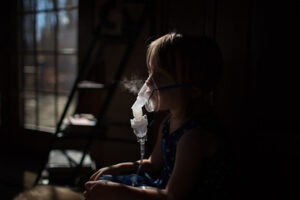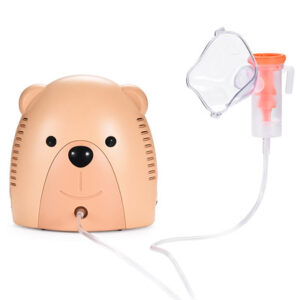In the realm of pediatric healthcare, ensuring the well-being of our little ones is paramount. When it comes to respiratory health, a nebulizer emerges as a game-changer. This article unfolds the significance, types, usage tips, and common concerns regarding nebulizers designed specifically for children.

Understanding Nebulizer For Kids :
A. What is a Nebulizer?
A nebulizer is a medical device that transforms liquid medication into a fine mist, allowing children to inhale it directly into their lungs. It’s a non-invasive and effective way to administer medication for respiratory conditions.
B. How Does a Nebulizer Work?
Nebulizers work by utilizing compressed air or ultrasonic power to convert liquid medication into a mist. This mist is then inhaled through a mask or mouthpiece, reaching the lungs and providing targeted relief.
Table of Contents
ToggleThe Importance of Nebulizers for Kids
A. Managing Respiratory Conditions
Nebulizers are instrumental in treating a range of respiratory issues in children, including asthma, bronchitis, and respiratory infections. The direct delivery of medication to the lungs ensures rapid and effective relief.
B. Ease of Administration for Children
Unlike traditional methods, such as oral medications or injections, nebulizers make the administration of medication less intimidating for children. The mist is inhaled naturally during breathing, making it a more comfortable experience.
Types of Nebulizers for Kids
A. Piston-Powered Nebulizers
Known for their reliability and efficiency, piston-powered nebulizers are suitable for children. They deliver medication effectively, ensuring optimal respiratory care.
Ultrasonic Nebulizers
These nebulizers use ultrasonic vibrations to create a fine mist. They are often quieter than piston-powered ones, making them a suitable choice for children who may be sensitive to noise.
Choosing the Right Nebulizer for Your Child
A. Consideration of Size and Weight
Select a nebulizer that is lightweight and easy to handle, considering your child’s size and age. This ensures that the device is user-friendly and can be managed independently by older children.
B. Noise Levels and Kid-Friendly Features
Take into account the noise levels of the nebulizer. Opt for models with quiet operation, and explore features like colorful designs or child-friendly masks to make the experience more appealing for younger users.

Safety Measure of Nebulizer for kids
A. Cleaning and Maintenance
Regular cleaning is crucial to prevent bacterial growth. Follow the manufacturer’s guidelines for cleaning and maintenance, ensuring the nebulizer is free from contaminants.
B. Supervision During Usage
While older children can use nebulizers independently, it’s essential to supervise younger ones to ensure proper usage. This includes correct assembly, inhalation technique, and cleaning procedures.
Tips for Administrating Nebulizer for kids
A. Creating a Comfortable Environment
Establish a calm and comfortable environment during nebulizer sessions. This can include soft lighting, a favorite blanket, or playing soothing music to alleviate any anxiety.
B. Ensuring Proper Medication Dosage
Work closely with your healthcare provider to determine the correct dosage for your child’s specific condition. Accurate dosing is crucial for effective treatment.
VIII. Overcoming Challenges in Nebulizer Usage
A. Dealing with Resistance
Children might initially resist using a nebulizer. Engage them by incorporating elements of play, storytelling, or allowing them to choose a favorite mask design.
B. Addressing Common Side Effects
Some children may experience mild side effects. Consult with your healthcare provider to address any concerns and determine if adjustments to the medication or treatment plan are necessary.
IX. Making Nebulizer Time Fun for Kids
A. Incorporating Games and Distractions
Transform nebulizer time into an enjoyable activity by incorporating games or distractions. This not only reduces resistance but also makes the experience positive for the child.
B. Positive Reinforcement
Praise and positive reinforcement can go a long way in creating a positive association with nebulizer use. Offer rewards or encouragement to reinforce the importance of the treatment.
Frequently Asked Questions (FAQs)
A. What age is appropriate for a child to start using a nebulizer?
The use of a nebulizer can begin at any age, depending on the respiratory condition diagnosed by a healthcare professional.
B. Can I use essential oils in a nebulizer for my child?
No, it is not recommended to use essential oils in a nebulizer designed for medication administration. Stick to prescribed medications for respiratory conditions.
C. How often should I clean my child’s nebulizer?
Cleaning should be done after each use. Follow the manufacturer’s guidelines for specific cleaning instructions.
D. Are there portable nebulizers suitable for kids?
Yes, many portable nebulizers are designed with features specifically catering to children, providing effective on-the-go respiratory care.
E. What should I do if my child refuses to use the nebulizer?
Engage your child during nebulizer time through play, storytelling, or positive reinforcement. Consult with your healthcare provider if resistance persists.
Conclusion About Nebulizer For Kids
In conclusion, a nebulizer for kids is not just a medical device; it’s a tool that ensures your child breathes comfortably. By understanding its importance, choosing the right one, and implementing safety measures, you can make this part of your child’s routine seamless.
